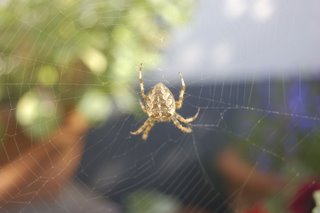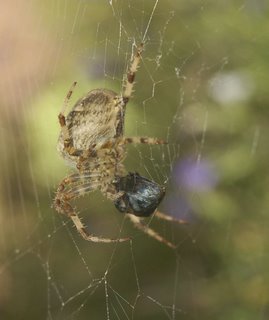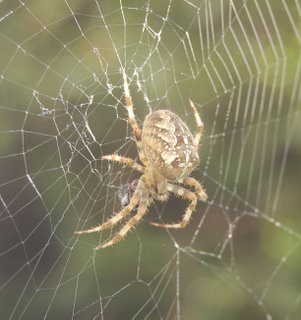 We have a BIG spider in our garden. She's been weaving her web between a few of our pots over the summer. Right now, she's settled in the leaf of a poppy, and is going back and forth between it and a number of other pots, re-weaving her web as it gets destroyed by rain every few days.
We have a BIG spider in our garden. She's been weaving her web between a few of our pots over the summer. Right now, she's settled in the leaf of a poppy, and is going back and forth between it and a number of other pots, re-weaving her web as it gets destroyed by rain every few days.I sowed poppy seeds we collected from Airfield in a pot a few weeks ago, way too late in the season for poppies, but they grew well and we had our first flower yesterday morning, a beautiful crisp autumn morning.
We had spotted the spider on her web in that area on and off over th
 e last couple of months. A few days ago, we watched her as she cut a faded petunia flower from her web. She was amazingly fast.
e last couple of months. A few days ago, we watched her as she cut a faded petunia flower from her web. She was amazingly fast.We got a good look at her yesteday morning and managed to take a few pictures while she was wrapping a fly to take it off the centre of her web and - I assume - into her larder. Her body is about 2 cm long.
According to this website I have found, she is a garden spider. I have found on another website that they have a lifespan of 1 to 2 years. So, we'll keep you updated on her progress.
By the way, I'm calling it "her" as I have found on a website that the female is bigger than the male, which is only 4 to 8 mm in size. So this one is definitely a "she"!
By the way, don't forget to click on the pictures to see them in full screen size. She is a beauty!
According to wikipedia, it takes a lot to provoke them to bite, and the bite is just "slightly unpleasant"!
 And here is for the sad bit (well, they both die in the end!), which I've found on this website from the BBC:
And here is for the sad bit (well, they both die in the end!), which I've found on this website from the BBC:" The much-smaller male waits near the web of the female until she is mature. He then cautiously approaches her while plucking the strands of the web to let her know that he is not food. If the male survives after mating, he may go on to mate again. Occasionally though, the male is mistaken for a meal and is eaten by the female.
After the female has mated, her body will become swollen with eggs. The female then builds a silken egg sac and lays her eggs in it. Her life is now dedicated to protecting these eggs and she will sit with them, unable to hunt, until she dies in late autumn. The spiderlings will hatch out in May of the following year."
No comments:
Post a Comment